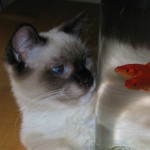In October of 1859, a white Maltese mix named Nero was run over by a cart on a West London street. The dog suffered for months before his owner, the notable Scottish letter writer Jane Welsh Carlyle, could bring herself to have him put to sleep. “I grieve for him as if he had been my little human child,” she wrote a friend. In her note, Carlyle spoke of her “belief in the immortality of animal life” and of her desire to know if she would see Nero again in the hereafter. “What is become of that little beautiful, graceful Life?”
That’s a question a lot of pet owners were beginning to ask at the time. For only if dogs and cats had souls could they evolve from mere companions to family members—a transformation that would eventually set them on the road to personhood.
Carlyle lived in the Victorian era, a period that marked a dramatic rebound in the status of cats and dogs. Though both pets had once been highly revered—cats in Ancient Egypt, dogs in Ancient Rome—the Middle Ages had taken its toll. Back then, the animals were blamed for spreading death and disease, and thousands were slaughtered. Cats in particular were vilified. In 1233, Pope Gregory IX issued his Vox in Rama proclamation, which linked felines with the devil, and for centuries cats were thrown into bonfires and tortured as allies of witches and incarnations of Satan. Dogs fared slightly better, though in the seventeenth century they became popular subjects of vivisection. Early practitioners, including the famed French philosopher Rene Descartes, had no compunction about dissecting them alive. Animals were mere machines, he said, devoid of thought and emotion. Once revered as gods, dogs and cats had been robbed of their souls.
By the mid 1800s, however, thanks to the Victorian era’s ideals of kindness and sentimentality, cats and dogs had clawed their way back into the human heart. More attention and love was lavished on them than ever before. In paintings and books, they featured as an indispensable part of domestic life. It’s perhaps no surprise then that people like Jane Welsh Carlyle began to wonder if they would see their pets again in heaven—speculation that set up a battle with the Bible.





